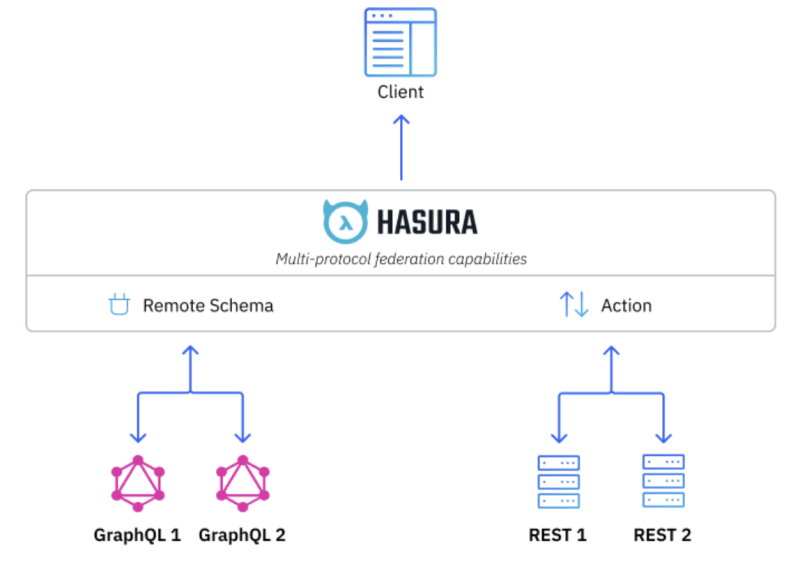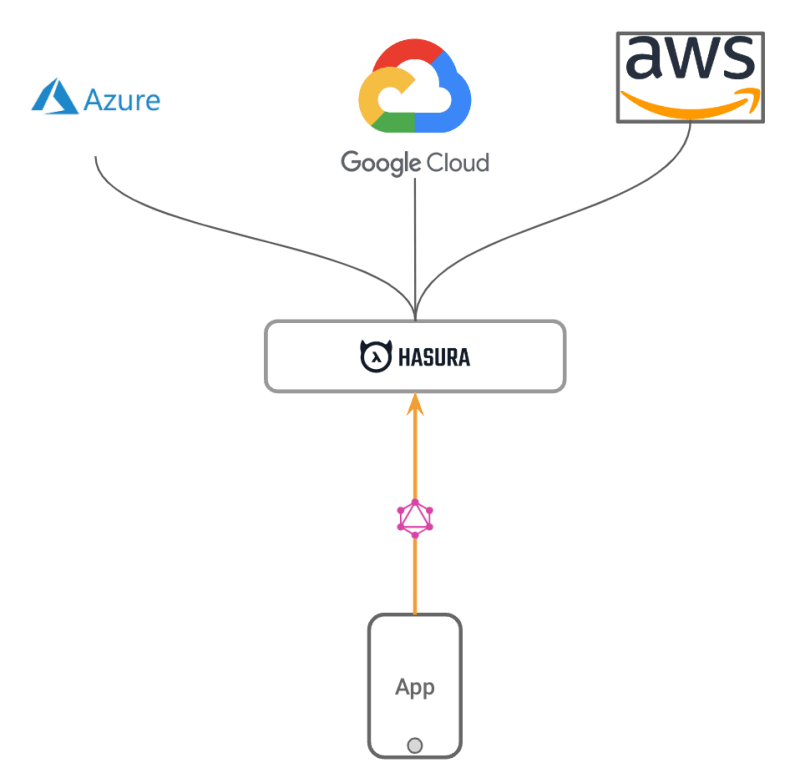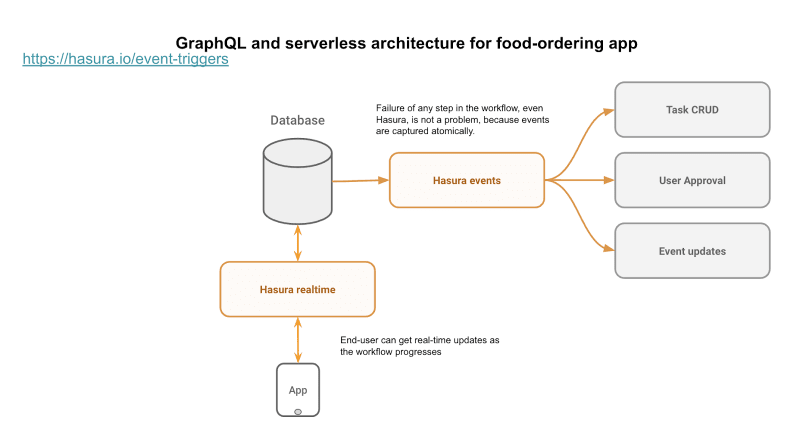In today's dynamic digital landscape, organizations are constantly exploring advanced API strategies to build robust and scalable applications. Hasura, a powerful GraphQL engine, provides a transformative solution for unlocking the potential of these strategies.
In this blog post, we will explore how Hasura revolutionizes the API ecosystem by enabling data aggregation, supporting microservices and federated GraphQL, facilitating serverless architecture, enabling multi-cloud strategies, and empowering real-time updates and event-driven APIs.
Hasura as a data aggregator
Hasura's ability to automatically generate APIs based on existing databases makes it an exceptional data aggregator. By integrating Hasura with your API infrastructure, you can effortlessly consolidate data from multiple sources into a unified GraphQL schema.
This federation capability allows you to access, query, and manipulate data from diverse backends through a single GraphQL endpoint. The result is a cohesive API ecosystem that simplifies data access, accelerates development and enhances data-driven decision-making.
Use Case: E-commerce aggregation
- Hasura connects to various product databases, inventory management systems, and payment gateways.
- Hasura aggregates product data, inventory levels, and payment information into a unified GraphQL endpoint.
- Clients can efficiently fetch all the necessary information for an e-commerce application from a single API, eliminating the need for multiple round trips to different services.
Architecture
In this architecture, Hasura acts as the data aggregator for an e-commerce application. Hasura connects to multiple data sources, including product databases, a payment gateway, and an inventory system. It consolidates the data from these sources into a unified GraphQL endpoint.
Clients interact with Hasura's GraphQL API to fetch product information, process payments, and manage inventory. Hasura efficiently aggregates the required data from various sources, eliminating the need for clients to make multiple API requests.
By using Hasura, the e-commerce application benefits from streamlined data retrieval, reduced latency, and improved performance. Clients can retrieve all the necessary information from a single GraphQL endpoint, providing a seamless and efficient user experience.
Microservices architecture
Microservices architecture promotes modular and decoupled services, enabling organizations to efficiently scale and evolve their applications. Hasura plays a pivotal role in such architectures by acting as a federated GraphQL layer that orchestrates communication between microservices.
By integrating Hasura with your microservices infrastructure, you can seamlessly aggregate and compose data from different services, simplifying the development process and providing a unified API interface for clients.
Use Case: Social media analytics dashboard
- Hasura serves as a federation for multiple microservices, including user management, social media data retrieval, and analytics.
- Each microservice exposes its own GraphQL endpoint, and Hasura aggregates the data from these services.
- Hasura applies security policies, rate limiting, and caching to provide a unified and secure API for the analytics dashboard, improving performance and data consistency.
Architecture
In this architecture, each microservice handles specific functionalities within the application. Hasura serves as the centralized entry point for API requests, routing traffic to the appropriate microservices.
Clients interact with Hasura's GraphQL API, which applies security, rate limiting, and caching policies to the requests. Hasura aggregates the responses from the microservices and presents a unified API to the client. This approach simplifies client-side integration and improves performance by reducing the number of network requests.
By using Hasura, organizations can enforce consistent security policies, manage API traffic efficiently, and provide a unified interface for clients. Additionally, Hasura's data composition capabilities allow clients to fetch and combine data from multiple microservices, providing a seamless and cohesive user experience.
Federated GraphQL with Hasura
Hasura's support for federated GraphQL enables organizations to build distributed systems that span across multiple data sources. By integrating Hasura into your API ecosystem, you can federate GraphQL schemas from various services and data providers.
This approach promotes data virtualization, allowing clients to interact with a unified GraphQL schema while abstracting the complexities of the underlying data sources.
Federation architecture should ideally be used when you have access to all your sources and high-performance joins across databases are required. With federated GraphQL and Hasura, you can achieve a seamless, consistent, and flexible data access layer.
Use Case: Travel booking platform
- Multiple GraphQL services, managed by different teams, handle various travel-related functionalities like flights, hotels, and car rentals.
- Hasura acts as the federation, combining these services into a single unified API.
- Hasura's data composition capabilities allow clients to fetch data across different services seamlessly, enabling a cohesive travel booking experience.
Architecture
In this architecture, Hasura acts as the federation for multiple GraphQL services (GraphQL Service 1, GraphQL Service 2, GraphQL Service 3). Each GraphQL service is managed by different teams and handles specific functionalities.
Hasura, as the federation, combines these individual GraphQL services into a single, unified API. Clients interact with Hasura's GraphQL API, which orchestrates and delegates requests to the respective services. Hasura's data composition capabilities allow clients to seamlessly fetch data from across the federated services, providing a cohesive and integrated experience.
By leveraging Hasura as the federation, organizations can adopt a micro-frontend architecture, where different teams manage their own GraphQL services independently. Hasura handles the composition and aggregation of data, reducing the complexity of client-side integration and enabling a scalable and modular architecture.
Serverless architecture
Serverless architecture enables organizations to focus on writing business logic without the need to manage infrastructure. Hasura seamlessly integrates with serverless platforms, allowing you to leverage its powerful GraphQL capabilities within serverless functions.
By utilizing Hasura in serverless architecture, you can build dynamic APIs, handle real-time updates, and trigger event-driven workflows. This combination empowers developers to create scalable and cost-effective serverless applications with ease.
Use Case: Serverless chat application
- Hasura acts as the entry point for incoming chat messages and user actions.
- Based on the GraphQL queries or mutations, Hasura invokes serverless functions to handle specific functionalities.
- Hasura's dynamic invocation of serverless functions enables a scalable and event-driven API architecture for real-time communication in the chat application.
Architecture
In this architecture, Hasura acts in a serverless environment. The system consists of multiple serverless functions, such as AWS Lambda or Azure Functions, which handle specific API endpoints or functionalities.
Clients interact with Hasura's GraphQL API, which acts as the entry point for API requests. Based on the GraphQL queries or mutations, Hasura dynamically invokes the corresponding serverless functions. This approach enables a scalable and event-driven API architecture.
Hasura's capabilities allow for centralized management of security, rate limiting, and caching policies. It simplifies the coordination and invocation of serverless functions, reducing the complexity of managing individual API endpoints.
By utilizing Hasura in serverless architecture, organizations can achieve agility, scalability, and reduced development effort. Hasura's dynamic invocation of serverless functions enables efficient handling of API requests and provides a seamless experience for clients.
Multi-Cloud strategy with Hasura
With the increasing adoption of multi-cloud strategies, organizations are leveraging the strengths of different cloud providers to optimize performance, reliability, and cost. Hasura enables seamless integration with multiple cloud environments, allowing you to deploy and manage your APIs across different cloud providers.
By leveraging Hasura's multi-cloud capabilities, you can achieve workload distribution, improve redundancy, and mitigate vendor lock-in, ensuring a resilient and flexible API architecture. You can check out our blog, Multi-Cloud and Multi-Region Deployment Strategy for Distributed Postgres.
Use Case: Hybrid cloud e-commerce platform
- Hasura is deployed across different cloud providers, such as AWS, Azure, and Google Cloud.
- Hasura provides consistent API management and security policies across all cloud environments.
- Clients interact with a unified API, seamlessly accessing services and data regardless of the underlying cloud infrastructure, enabling a hybrid cloud e-commerce platform.
Architecture
In this architecture, Hasura serves in a multi-cloud strategy. The infrastructure is deployed across different cloud providers, such as AWS, Azure, and Google Cloud.
Clients interact with Hasura's GraphQL API, which acts as the entry point for API requests. Hasura provides consistent API management, security policies, and caching mechanisms across all cloud environments.
Hasura shields the clients from the underlying cloud infrastructure, enabling seamless access to services and data regardless of the specific cloud provider. This approach allows organizations to adopt a hybrid cloud strategy and leverage the benefits of different cloud platforms without exposing the complexities to clients.
By using Hasura in a multi-cloud architecture, organizations achieve flexibility, scalability, and resilience. Hasura ensures a consistent and secure API experience for clients, regardless of the cloud infrastructure powering the backend services.
Note: The architecture diagram is a high-level representation and may vary depending on specific implementation details and infrastructure choices.
Real-time updates and event-driven APIs
Real-time updates and event-driven APIs are essential for applications that require instant data synchronization and real-time communication. Hasura provides out-of-the-box support for real-time subscriptions, enabling instant updates to connected clients when relevant data changes occur.
By integrating Hasura into your API strategy, you can build event-driven architectures, implement real-time collaborative features, and create interactive applications that deliver a superior user experience.
Use Case: Real-time collaborative task management
- Hasura subscribes to changes in the task management database, such as task updates or new task assignments.
- Hasura pushes real-time updates to connected clients, allowing instant synchronization and collaboration among team members.
- Clients receive real-time notifications, live task updates, and instant feedback, enhancing productivity and collaboration within the task management application.
Architecture
In this architecture, Hasura serves for a real-time collaborative task management application. The application utilizes a task management database to store task-related information.
Clients interact with Hasura's GraphQL API, which acts as the entry point for API requests. Hasura subscribes to changes in the task management database, such as task updates or new task assignments. When a relevant event occurs, Hasura pushes real-time updates to the connected clients.
Clients receive real-time notifications, live task updates, and instant feedback through the GraphQL subscriptions provided by Hasura. This enables seamless collaboration and synchronization among team members in the task management application.
By leveraging Hasura with real-time capabilities, organizations can build interactive and collaborative applications that provide timely updates and enhance productivity.
Summary
Hasura, with its advanced capabilities in data aggregation, microservices architecture, federated GraphQL, serverless architecture, multi-cloud strategies, and real-time updates, unlocks a new realm of possibilities for building advanced API strategies.
By integrating Hasura into your API ecosystem, you can achieve a highly flexible, scalable, and performant architecture that empowers developers and enables rapid innovation. Embrace the power of Hasura to revolutionize your API Strategy and stay ahead in the ever-evolving digital landscape.














Top comments (0)